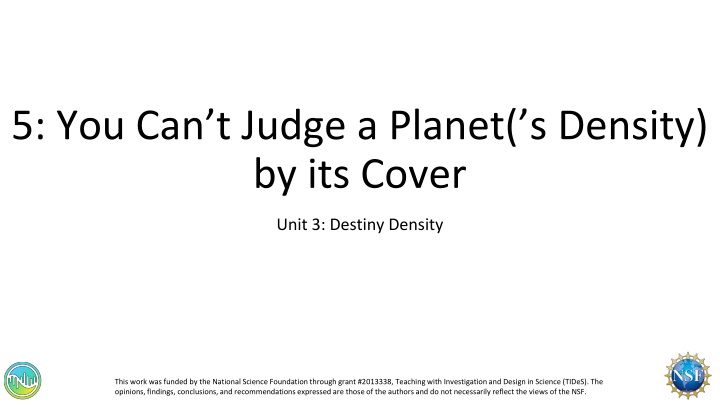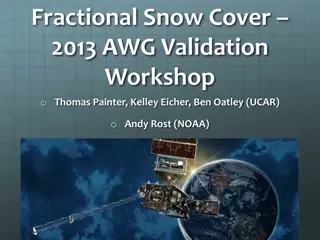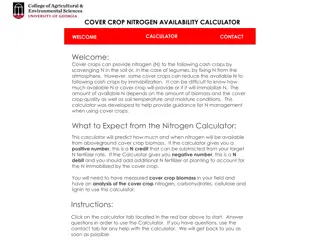by its Cover
Calculate density of various solids, including Earth's key layers, by comparing Earth, Moon, and Mars compositions. Understand the relationship between composition, density, and temperature in planetary structures.
Download Presentation

Please find below an Image/Link to download the presentation.
The content on the website is provided AS IS for your information and personal use only. It may not be sold, licensed, or shared on other websites without obtaining consent from the author.If you encounter any issues during the download, it is possible that the publisher has removed the file from their server.
You are allowed to download the files provided on this website for personal or commercial use, subject to the condition that they are used lawfully. All files are the property of their respective owners.
The content on the website is provided AS IS for your information and personal use only. It may not be sold, licensed, or shared on other websites without obtaining consent from the author.
E N D
Presentation Transcript
5: You Cant Judge a Planet(s Density) by its Cover Unit 3: Destiny Density This work was funded by the National Science Foundation through grant #2013338, Teaching with Investigation and Design in Science (TIDeS). The opinions, findings, conclusions, and recommendations expressed are those of the authors and do not necessarily reflect the views of the NSF.
Learning Goals Calculating the density of various solids Practice approximating volume Apply and compare different methods of calculating density Calculate a scale model of our planet Examine relative depths/thicknesses of key layers inside our Earth and Contrast the rheological behavior of those layers within the context of their composition, density, and temperature
Reading & class discussion You read about the properties of liquids and solids - You were asked to be prepared to identify and explain factors that change the properties of liquids and solids and how they do so, What are some examples? Think-pair-share Write cause and effect statements for these examples https://t.ly/density
Remember Atoms? A mineral is a naturally occurring inorganic crystalline solid made of atoms (of specific elements). Atoms are the building blocks of matter, and minerals are... matter! What can the density of a mineral tell you about its composition? Rocks are made of minerals And, the Earth is made of rocks
Compare Earth, the Moon, and Mars Earth Surface composed of water, granite, basalt Bulk density 5.5 g/cm3 Mars Surface composed of basalt Bulk density 3.9 g/cm3 Moon Surface composed of basalt Bulk density 3.3 g/cm3 Water Granite Basalt Density (g/cm3) 1 2.65-2.75 2.9-3 Think-Pair-Share What can we infer from the discrepancy between the known surface materials and the measured bulk density?
Compare Earth, the Moon, and Mars The bulk density measurements imply that there are other below- surface (unseen) materials that must be contributing to increasing the overall density The same is true for inferring the structure of other planets Surface composition is determined from spectroscopy by spacecraft Volume is determined by measuring radius Density is determined by using a mathematical formula (Kepler s 3rdlaw) and measured distances, angles, and orbital period
Not Hollow, Not Inhabited by Giants Some conspiracy theorists believe that the Earth is hollow and that we are living on the inside of it! How do we know that the Earth isn't hollow? Two main factors: 1. Gravity requires mass 2. Magnetic field requires a metallic core composed of at least one of three possible metals (iron, nickel, or cobalt: recall atoms lecture), and for some of that metal to be fluid/flowing to generate electric currents.
5: You Cant Judge a Planet by its Cover Measuring Earth Materials Density Unit 3: Destiny Density This work was funded by the National Science Foundation through grant #2013338, Teaching with Investigation and Design in Science (TIDeS). The opinions, findings, conclusions, and recommendations expressed are those of the authors and do not necessarily reflect the views of the NSF.
Learning Objectives Calculate the density of various solids Practice approximating volume Apply and compare different methods of calculating density
Materials Solids to measure (e.g.) Wood blocks Rocks (olivine & calcite) Steel balls & marbles (glass) Scales Water Volume measurement devices (e.g.) Rulers Graduated cylinders and/or beakers
Recall calculating the densities of liquids? Yes, this is similar
Instructions Pairs or Small Groups Work in groups to share equipment and use rulers, scales, beakers or graduated cylinders to make your density calculations Each group will be responsible for calculating the density for each of the solids provided using two different methods Direct volume measurement/estimation Volume by displacement
Instructions Determine the mass of the solids with the scale (grams) Determine the volume of the solids by measurement and estimation Then, determine the volume of the solids displacement Record these data into your data tables (observations) Use these data to calculate the density of the solids
Measuring Density of Solids Solid Density Calculation Table A B C D E Density (g/cm3) =A/B Density (g/cm3) =A/C Solid Mass (grams) Volume by measurement (cm3) Volume by displacement (ml) Olivine Calcite Steel ball Marble Wood block
W = 5m Volume by Measurement H = 10m Measure the length, width, and height of your solid objects. For irregular objects you will need to approximate the shape to be a "rectangle". Calculate the volume of your "rectangles" by using the formula v = LxWxH For your sphere you need to try to measure the diameter. Calculate the volume of your sphere by using the formula v = (4/3) r3 Volume should be reported in cm3 r
Volume by Displacement For the displacement method you will need a vessel in which you can fit your object and accurately read volume. Halfway fill the vessel with water Note the volume of water you start with (ml). Next, immerse your object and note the new volume reading (ml). Subtract the volume of water that you started with from this and that will give you the volume of the object you immersed inside.
Discussion Part 1 Which of these methods do you think is the most accurate? The most approximate? Why? What data do you need to check your answers (or hypotheses)?
Sharing Data Gather class dataset to calculate average density and standard deviation for each solid by method Measurement Avg. Std. Dev. Displacement Avg. Std. Dev. Solid A B C D
Sharing Data Discussion Part 2 Do your (the class) data support your measurements/hypotheses? What are some possible sources of error with our measurements?
Interpret & Apply (Discussion Part 3) What can we predict from these data about the structure and composition of Earth's layers? (Hint: think about the bulk density comparison between Earth, the Moon & Mars) What additional information or supplemental data do you need to refine your inferences about Earth s interior?
Earth Materials Density Wrap Up What can you infer about the structure and composition of Earth s interior? What additional information or supplemental data do you need to refine your inferences about Earth s interior?
5: You Cant Judge a Planet by its Cover Visualizing Earth s Layers Unit 3: Destiny Density This work was funded by the National Science Foundation through grant #2013338, Teaching with Investigation and Design in Science (TIDeS). The opinions, findings, conclusions, and recommendations expressed are those of the authors and do not necessarily reflect the views of the NSF.
Learning Objectives Calculate a scale model of our planet Examine relative depths/thicknesses of key layers inside our Earth and Contrast the rheological behavior of those layers within the context of their composition, density, and temperature
Jigsaw Activity - Earths Layers - Part 1 Part 1 We will split up into groups and each group will become experts on one of four specific topics that will help us all understand the properties and structure of the Earth s interior Group 1: What are mechanical properties of materials? Group 2: How do seismologists see inside the Earth? Group 3: What is the geothermal gradient and how does temperature relate to Earth s structure and function? Group 4: What is isostasy and how on Earth does it work?
Materials for Group 1 Rulers Materials representing different rheological properties: Popsicle sticks (brittle) Slime (viscous fluid) Plastic (plastic...) Wire - paperclips? (malleable) Rubber bands (elastic) Non-Newtonian fluid (1.5C cornstarch + 1C water; silly putty) Earth materials Wood blocks Rocks Steel balls
Jigsaw Activity - Earths Layers - Part 2 Now that you have become experts on your assigned topic, it s time to teach your peers! We will re-group such that each new group has one member of each of the original groups in it. Begin by sharing out the key concepts from each of your topics and discuss the questions on the following slide After that, you will work together to fill in the data table with the information from all of your topics.
Jigsaw Activity - Earths Layers - Part 2 How do you know that Earth s interior must be different compositionally from its surface? Is a layered internal structure logical? Predicted? Explain why/why not. Explain how it can be possible for rocks (etc.) to behave in a brittle, plastic, non-Newtonian, and even fluid manner within the Earth. Consider the data that you have collected in your table for all of Earth s layers.
Data Table Set Up Layer Thickness Scaled Phase Composition Mechanical behavior Temperature (km) (cm) (solid/liquid/gas) (plastic/brittle) C Earth s Interior Crust Lithosphere Asthenosphere Mantle Outer core Inner core Layers of the atmosphere Thermosphere Mesosphere Stratosphere Troposphere don t forget the ocean!
Jigsaw Activity - Earths Layers - Part 3 You will be generating a scaled and annotated drawing of the Earth's layers Your annotations should include name total layer thickness temperature mechanical behavior and analogous material of that property composition any other fun facts you wish to add
Instructions Annotated Drawing Set Up You first need to create a single long (tall) sheet of paper on which you will create your scaled annotated drawing of the Earth's interior Scaling the Earth's layers at a ratio of 100 km (real world) = 1 cm (drawing) and including the layers of the atmosphere, we will be representing 6873 km and will need 69 cm of space to fit the drawing. Complete your scale calculations for the thickness of each layer first
Instructions Then measure your drawing of Earth s layers, beginning at the bottom of the long page at a point representing the center of the Earth Measure up from there the thickness of the inner core. Since each layer's value is a thickness, it is simply measured from the top of the previous layer. Annotate each layer with the name, thickness and properties that layer holds
Wrap up discussion The layers of the Earth are classified according to two main criteria: 1. Chemical composition and 2. Mechanical behavior. Based on chemical composition, Earth is divided up into three layers: 1. Crust, 2. Mantle, and 3. Core. Each is dominated by different chemical elements. The crust contains lighter elements, the mantle is richer in magnesium and iron, and the core is mostly iron and nickel.
Wrap up discussion Based on mechanical behavior, Earth is divided up into five main layers: 1. Lithosphere, 2. Asthenosphere, 3. Mesosphere, 4. Outer core, and 5. Inner core. Except for the liquid outer core, all layers of the Earth are solid, but even the solid layers can change shape and "flow" over geological time scales (millions of years).
Think-Pair-Share The layers of the Earth are classified according to two main criteria: 1. Chemical composition and 2. Mechanical behavior. Explain how Earth s interior layers are stratified in ways that are both similar and different to the layers of the atmosphere and ocean.























